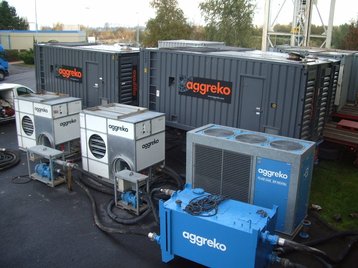Data centers are essential to delivering many daily services that society relies on, including communications, energy systems, transport and health services. As more data centers are popping up across the globe, it’s critical to identify suitable locations to ensure optimal efficiency performance.
A critical factor in this decision is ensuring the site has an adequate electricity supply to power and cool its facilities, as data centers are large energy users and add significant electrical loads to existing electricity infrastructures. In some countries, systems are already operating near to full capacity, so new data centers place significant additional strain on the local and national electricity grid.
Although there are minor challenges to temporary gas generation, overall it offers a practical and reliable solution because gas generators can provide the power needed to enable new or expanding data centers to become operational - from construction and commissioning to their eventual day-to-day running - at least until electricity from the grid starts to flow.
Here are the pros and cons of gas-powered rental generation.
Sustainable power
Data center operators have been using diesel generators as emergency backup/standby power at their sites for many years. Consequently, they’ve also used them to overcome grid supply challenges and help them bridge the power supply gap to get their new data servers online on time. However, continuously using diesel generation as a substitute for mains power over long periods of time is not cost-effective or sustainable.
Diesel generators are used for standby duty applications because they can accept significant load steps after a power outage, so they can be quickly brought online to take over from a site’s UPS system. However, diesel generators need a robust and often costly fuel management strategy, taking into account the logistical and safety issues surrounding regular refueling.
Diesel generators have long-term environmental implications as well. Many local governments or authorities will raise concerns about the long-term continuous use of diesel generation within built-up and densely populated areas, due to the harmful and damaging effects of NOx pollutants. Changes in building regulations and a tightening of planning controls mean that developers are expected to explore alternative options to minimize energy waste, greenhouse gas emissions and improve air quality.
Additionally, using combined heat and power technology, waste heat from the cooling system of the generators’ engines could produce an additional electricity supply for the site. This process is more efficient and has lower greenhouse gas emissions than electricity coming from conventional power station generation. The waste heat could also be diverted for use with an absorption chiller unit to provide chilled water for use in the data center’s cooling systems.
Overall, gas is a cleaner energy source producing fewer emissions than diesel, so gas generation is more favorable than diesel for continuous operation.
Grid synchronization
Like diesel variants, gas generators effectively synchronize with the electricity grid, operating in parallel with the incoming electricity supply. This is achieved in the following ways:
- Gas generation produces a constant power output, providing base load power at a potentially lower price than electricity from the grid. The data center uses the grid supply to meet varying loads above the base load.
- Gas generation is used in addition to the existing grid supply, therefore providing additional capacity. Typically, the gas generators would still take the constant base load of the site and the grid would support any varying load.
Advanced planning is necessary because the connection and design of parallel mode generation require the local network operator’s approval.
Standalone, continuous power
Gas generators can also run in island mode – where they are not connected or synchronized with the electricity grid – making it suitable for sites with sufficient medium or high-pressure gas supply already available but with no available mains power. The operator effectively uses the gas generators as the site’s utility provider, building its own mini power station to supply operations.
High resilience standard
The most critical factor to a data center’s power strategy is resilience, and for a gas generation to be effective, sites must be able to configure a set-up that meets the highest resilience standards.
Most operators design their data centers with a minimum level of redundant power to ensure a high level of resilience to downtime as a result of UPS malfunctions, standby generator failures or total mains power outages. A site’s primary infrastructure needs to be fully redundant to achieve Tier IV of the Uptime Institute’s tier system and deliver 99.995 percent uptime per year.
While every project is different and often different generator configurations can be used to achieve a site’s required redundancy level, gas-powered generation can reach Tier IV and redundancy of 2N+1.
Drawbacks are real
Given that many data centers are in highly-populated areas, the biggest impediment to temporary natural gas-powered generation is finding accessible and available natural gas to accommodate the generators.
There are additional costs associated with installing pipeline infrastructure from the utility provider to the temporary generator although the long-term cost savings of using natural gas over diesel is tremendous and even offset the costs related to the pipeline installation.
Also, there are fuel alternatives if natural gas is unavailable. Companies could use liquid natural gas or compressed natural gas although costly and comes with rigorous regulation hurdles. However if this means getting the site up and running 12-18 months quicker, it may still be cost effective, especially in comparison to a diesel solution.
In conclusion, as data centers evolve and power generation companies in recent years investing heavily in research and development programs to advance gas generation technology, temporary gas generation is a viable alternative to diesel. Not only can these generators help bridge the gap when electricity networks cannot deliver on a data center’s demands, they can also provide a more sustainable long-term substitute for mains power.


